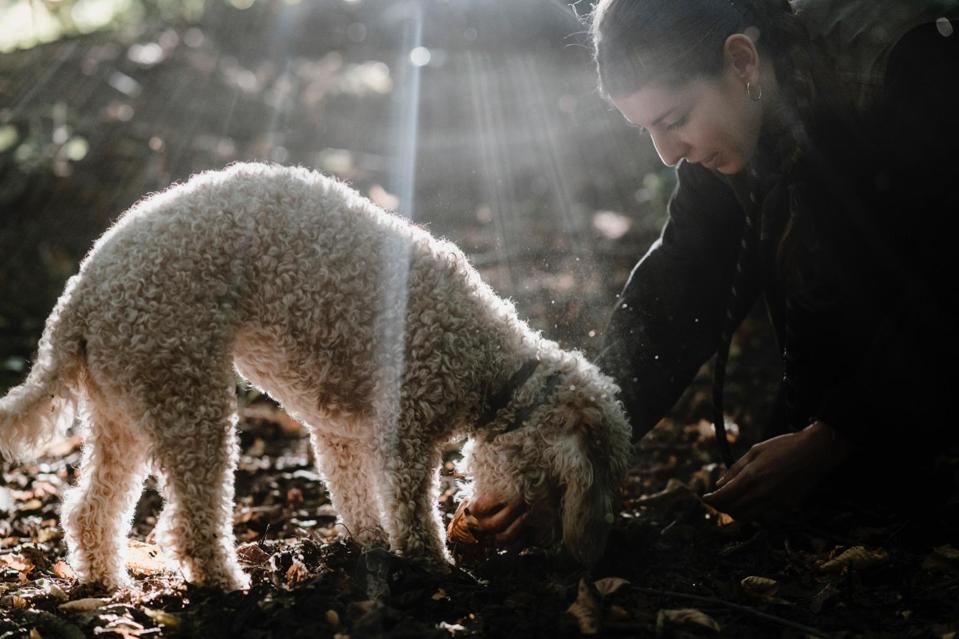Truffle Season In Italy
It’s officially white truffle season in Piedmont and Italian foragers are hoping this winter proves more fruitful than the last, which was reported as the worst in forty years due to unusual weather conditions caused by the climate crisis. With the International White Truffle Festival set to take place in Alba from mid-October to mid-December, travelers to northern Italy have the opportunity not only to taste this rare fungi, but also to support those who find them for us.
Below ground, truffles are governed only by the laws of Mother Nature, but above the topsoil they’re regulated by regional legal systems. According to Piedmont law, it is illegal to harvest truffles during the months of May and September. These periodic pauses are implemented for the health of the ecosystems where truffles thrive and encourage more abundant harvests during their peak growth season, from October to December.
Truffles And Tourism
Marta Menegaldo has worked as a truffle hunter–trifulau in the local dialect–since 2019, when she and her partner, Daniele Stroppiana, founded Bianco Tartufi. “Before, it was a hobby,” says Menegaldo, recalling how the business began when they bought their first Lagotto Romagnolo–an Italian dog breed known for its ability to sniff out truffles. Six years later, the couple now cares for four truffle dogs and works with them year-round. They are busiest in the last three months of the year–at which time they are dedicated to foraging and selling truffles–while in the off-season they train truffle dogs and lead guided tours. Diversifying their revenue streams in this way has been essential for the sustainability of their business, especially as climate change impacts the region.
“The white truffle brings us the highest income, but is more difficult to find year by year,” says Menegaldo. “The tours are as fundamental as the truffles to support us economically.”
Bianco Tartufi also collaborates with other local businesses, including Untold Italy, which hosts small group travel experiences through the country. Through the Untold Italy Piedmont Tour, travelers spend a day foraging with Bianco Tartufi before heading to a restaurant to dine on truffles. The company also offers similar experiences in two of Italy’s other top truffle producing regions, Tuscany and Umbria.
Founder Katy Clarke explains, “Tourism in Italy has always been very focused on certain areas and attractions, but this has really intensified since COVID and with social media. We offer opportunities for people to go and experience different parts of the country and the countryside, which is what we’re most passionate about.”
The chance for travelers to speak directly with the foragers, to see how they work with the dogs, and to even get one’s hands dirty unearthing a truffle provides invaluable insight into why these fungi are presented at markets and restaurants with such fanfare. When a server appears at a dinner table with a miniature scale to weigh a truffle before shaving it over pasta, it’s not just a matter of formality or some kind of formulated exclusivity–it reflects the authentic rarity of this ingredient.
The Fragile Future Of Italian Truffles
Shrouded in mystery and cloaked in a fine layer of dirt, truffles are unlike anything else we eat. They are nearly impossible to cultivate consistently like other crops and, as wild ingredients, they are highly susceptible to changes within their ecosystem, particularly with regards to water and temperature.
“The white truffle is very delicate and it needs cold temperatures in fall and winter, which we don’t have anymore,” says Menegaldo. “The quantity and quality of truffles have drastically decreased in recent years.”
While those visiting Italy cannot control the weather, they can support Italian foragers by purchasing truffles directly from them, as well as participating in tours. And wherever you are in the world, you can learn more about what makes truffles so special–including through films set in Piedmont, such as Trifole and The Truffle Hunters.
“Our mission is to raise awareness and provide information about Italian truffles,” says Menegaldo. “Through our tours, clients gain a deeper understanding of truffle quality, seasonality, ripening, and other key aspects, becoming more informed and mindful consumers.”

